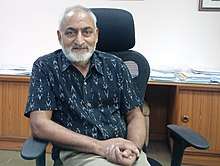Rakesh Mishra
Rakesh Kumar Mishra is an Indian scientist specializing in genomics and epigenetics.[3] Dr. Mishra is currently the Director of CSIR-Centre for Cellular and Molecular Biology (CCMB) in Hyderabad, India[4], and heads the 'Genome Organisation and Nuclear Architecture Lab' at CCMB.
Rakesh Mishra | |
|---|---|
 | |
| Born | 14 April 1961 [1] |
| Nationality | Indian |
| Alma mater | University of Allahabad[2] |
| Scientific career | |
| Fields | Genome Organisation, Chromatin Structure |
| Institutions | Centre for Cellular and Molecular Biology, Hyderabad |
Biography
He is an elected fellow of the Indian National Academy of Science, New Delhi,[5] the Indian Academy of Sciences, the National Academy of Sciences and the Andhra Pradesh Academy of Sciences.[2]
He is also a life member of Proteomics Society, India.[6] Dr. Mishra obtained his Masters in Chemistry[2] and Ph.D. in Organic Chemistry[2] from the University of Allahabad and was appointed Director CCMB by CSIR, assuming charge on 19 May 2016.[4] Dr. Mishra has also edited and contributed a chapter to the book, Chromosomes to Genome.[7]
Dr. Mishra had previously held post doctoral positions at the Molecular Biophysics Unit, Indian Institute of Science, Bangalore, University of Bordeaux, France and University of Geneva, Switzerland prior to joining CSIR-CCMB in 2001.[2]
Research Interests
Dr. Mishra investigates genome organisation focusing on evolutionarily conserved regions, structure of chromatin material and epigenetic regulation of genes during embryonic development stages.[4]
As a Director of CCMB
Dr. Mishra assumed charge of CCMB on 19th May, 2016. Some of the hallmark initiatives that he started in CCMB include:
- CCMB's efforts in developing lab-grown meat
- CCMB's fight against COVID-19
References
- http://www.insa.nic.in/writereaddata/UpLoadedFiles/PINSA/Vol80_2014_5_Art17.pdf
- http://www.biovoicenews.com/dr-rakesh-kumar-mishra-appointed-director-centre-cellular-molecular-biology/
- http://www.insaindia.res.in/pdf/YearBook_2016.pdf
- http://www.thehindubusinessline.com/news/rakesh-kumar-mishra-appointed-as-ccmb-director/article8620250.ece
- Rao, Ch Sushil (28 October 2014). "CCMB research finds B12 deficiency leads to low birth weight". The Times of India. Retrieved 21 March 2019.
- "List of Proteomics Society (India) Members". Proteomics Society, India. Proteomics Society, India. Retrieved 2 November 2016.
- Mishra, Rakesh K. (30 December 2013). Chromosomes to Genome. ISBN 9789380026213.